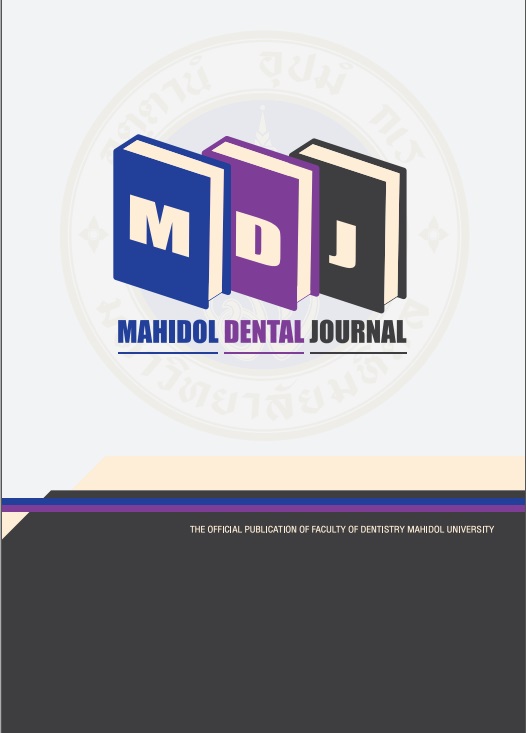Video games, audiovisual, and conventional distractions for pediatric dental patients: A crossover randomized controlled clinical trial
Main Article Content
Abstract
Objectives: To compare the effectiveness of Audiovisual (AV), Video games (VG), and Conventional (Co) distractions in pediatric dental patients.
Materials and Methods: Sixty healthy children, 6–9-years-old, with carious molars in three quadrants were treated with a local anesthetic, rubber dam, and caries removal over three visits. On the first visit, Co distraction was used, and the patients were then randomly divided into two groups, where Group A received VG, followed by AV, on their second and third visits, respectively, and Group B received the distractions in the reverse order. The Wong-baker FACES pain rating scale and a modified FLACC behavioral scale were used, and heart rate was measured.
Results: The patient’s behaviors were less disruptive when using VG than AV (p = 0.006) during the local anesthetic injection, during which VG alleviated pain (p = 0.036), promoted cooperative behavior (p = 0.007), and reduced heart rates (p = 0.0004).
Conclusion: VG was the most effective distraction to reduce disruptive behavior during local anesthetic injection.
Article Details
References
Klingberg G, Broberg AG. Dental fear/anxiety and dental behavior management problems in children and adolescents: A review of prevalence and concomitant psychological factors. Int J Paediatr Dent 2007; 17: 391-406.
Prado IM, Carcavalli L, Abreu LG, Serra-Negra JM, Paiva SM, Martins CC. Use of distraction techniques for the management of anxiety and fear in paediatric dental practice: A systematic review of randomized controlled trials. Int J Paediatr Dent 2019; 29: 650–68.
Mitrakul K, Asvanund Y, Arunakul M, Paka-akekaphat S. Effect of audiovisual eyeglasses during dental treatment in 5-8 year-old children. Eur J Paediatr Dent 2015; 16: 239-45.
Hoge MA, Howard MR, Wallace DP. Use of Video Eyewear to Manage Distress in Children During Restorative Dental Treatment. Pediatr Dent 2012; 34: 378-82.
Asvanund Y, Mitrakul K, Juhong R, Arunakul M. Effect of audiovisual eyeglass during local anesthesia injections in 5-to 8-year-old children. Quintessence Int 2015; 46: 513-21.
WilsonS. Nonpharmacologic issues in pain perception and control.In: Casamassimo PS, editors. Pediatric dentistry: infancy through adolescence.5th ed., St. Louis, Mo: Elsevier Saunders; 2013. p. 94.
Kleiber C, Harper DC. Effects of distraction on children's pain and distress during medical procedures: A meta-analysis. Nurs Res 1999; 48: 44-9.
Al-Khotani A, Bello LA, Christidis N. Effects of audiovisual distraction on children’s behaviour during dental treatment: a randomized controlled clinical trial. Acta Odontol Scand 2016; 74: 494-501.
Ram D, Shapira J, Holan G, Magora F, Cohen S, Davidovich E. Audiovisual video eyeglass distraction during dental treatment in children. Quintessence Int 2010; 41: 673-79.
Ei-Sharkawi HFA, El-Housseiny AA, Aly AM. Effectiveness of new distraction technique on pain associated with injection of local anesthesia for children. Pediatr Dent 2012; 34: 142-45.
Venham LL, Goldstein M, Gaulin-Kremer E, Peteros K, Cohan J, Fairbanks J. Effectiveness of a distraction technique in managing young dental patients. Pediatr Dent 1981; 3: 7-11.
Sullivan C, Schneider PE, Musselman RJ, Dummett CO Jr, Gardiner D. The effect of virtual reality during dental treatment on child anxiety and behavior. ASDC J Dent Child 2000; 67: 193-96.
Garrocho‐Rangel A, Ibarra‐Gutiérrez E, Rosales‐Bérber M, Esquivel-Hernández R, Esparza-Villalpando V, Pozos-Guillén A. A video eyeglasses/earphones system as a distracting method during dental treatment in children: A crossover randomised and controlled clinical trial. Eur J Paediatr Dent 2018; 19: 74-9.
Attar RH, Baghdadi ZD. Comparative efficacy of active and passive distraction during restorative treatment in children using an iPad versus audiovisual eyeglasses: a randomised controlled trial. Eur Arch Paediatr Dent 2015; 16: 1-8.
Soares FC, Lima RA, de Barros MVG, Dahllof G, Colares V. Development of dental anxiety in schoolchildren: A 2-year prospective study. Community Dent Oral Epidemiol 2017; 45: 281–88.
Lesaffre E, Philstrom B, Needleman I, Worthington H. The design and analysis of split-mouth studies: what statisticians should know. Stat Med 2009; 28: 3470–82.
Wong DL, Baker CM. Pain in children: Comparison of assessment scales. Pediatric Nursing 1988; 14: 9-17.
Garra G, Singer AJ, Taira BR,Chohan J, Cardoz H, Chisena E,et al. Validation of the Wong-Baker FACES Pain Rating Scale in Pediatric Emergency Department Patient. Acad Emerg Med 2010; 17: 50-4.
Merkel SI, Voepel-Lewis T, Shayevitz JR, Malviya S. The FLACC: a behavioral scale for scoring postoperative pain in young children. Pediatr Nurs 1997; 23: 293-7.
Voepel-Lewis T, Malviya S, Merkel S, Tait AR. Behavioral pain assessment and the face, legs, activity, cry and consolability instrument. Expert Rev Pharmacoecon Outcomes Res 2003; 3: 317-25.
Nilsson S, Finnstrom B, Kokinsky E. The FLACC behavioral scale for procedural pain assessment in children aged 5–16 years. Paediatr Anaesth 2018; 18: 767-74.
Rosenberg HM, Katcher AH. Heart Rate and Physical Activity of Children During Dental Treatment. J Dent Res 1976; 55: 648-51.
Rayen R, Muthu MS, Rayala CR, Nuvvula S. Evaluation of physiological and behavioral measures in relation to dental anxiety during sequential dental visits in children. Indian J Dent Res 2006; 17: 21-34.
Jurdi S, Montaner J, Garcia-Sanjuan F, Jaen J, Nacher V. A systematic review of game technologies for pediatric patients. Comput Biol Med 2018; 97: 89-112.
Eccleston C, Crombez G. Pain demands attention: a cognitive– affective model of the interruptive function of pain. Psychol Bull 1999; 125: 356–66.
Koepp MJ, Gunn RN, Lawrence AD. Evidence for striatal dopamine release during a video game. Nature 1998; 391: 266–68.
McCarthy FM. A clinical study of blood pressure responses to epinephrine-containing local anesthetic solutions. J Dent Res 1957; 36: 132-41.
Laufer DKA, Chosack A. Explanations as a means of reducing fear of dental procedures in children. The Alpha Omega 1964; 57: 130-33.
Chellappah NK, Vignehsa H, Milgrom P, Lam LG. Prevalence of dental anxiety and fear in children in Singapore. Community Dent Oral Epidemiol 1990; 18: 269-71.
Muppa R, Bhupatiraju P, Duddu M, Penumatsa NV, Dandempally A, Panthula P. Comparison of anxiety levels associated with noise in the dental clinic among children of age group 6-15 years. Noise Health 2013; 15: 190-93.


